annual report1-final.qxd - Overseas Indian
annual report1-final.qxd - Overseas Indian
annual report1-final.qxd - Overseas Indian
You also want an ePaper? Increase the reach of your titles
YUMPU automatically turns print PDFs into web optimized ePapers that Google loves.
Pravasi Bharatiya Divas<br />
Pravasi Bharatiya Divas<br />
Pravasi Bharatiya Divas<br />
Pravasi Bharatiya Divas<br />
of philanthropy. He tried to compare the non-<br />
<strong>Indian</strong> philanthropists’ work with that of <strong>Indian</strong><br />
American philanthropists and said both of them<br />
focused on education, and religion. If 0.1 percent of<br />
household income was spent for philanthropic<br />
work by the diasporic community, it would amount<br />
to Rs. 100 crore, he pointed out. Money was only<br />
one aspect but the frustration was about the huge<br />
documentation that FCRA still requires. Most of the<br />
money was intended to be spent on primary education<br />
and health. In terms of religion, lots of money<br />
was spent on repair of temples and mosques but<br />
one needed to try and persuade them to change the<br />
content towards health and education.<br />
Bhami Chennoy, Editor of Catalyst, said that there<br />
were all kinds of NGOs, good and bad. Nowadays,<br />
he said, there was a perception that to be associated<br />
with NGOs meant that one is with bad people.<br />
There was need for a paradigm shift. In fact, NGOs<br />
should be managed like profit organisations. These<br />
need fundamental research in identifying the critical<br />
factors and provide support in education, energy,<br />
water, food security, governance. He talked<br />
about developing NGO performance indicators<br />
and engaging the diaspora by building a philanthropy<br />
market place.<br />
“How can a sponsor pick up the information<br />
For instance, how can a child (needy) be chosen if<br />
someone wants to pay for his education Issue is,<br />
how do we bring them together”<br />
Chennoy said that basic things like choice, convenience<br />
and confidence for the philanthropists<br />
should be provided. He said one needed to think<br />
of philanthropy exchange, non-profit database,<br />
non-profit self-regulation and also ratings that<br />
could be authentically provided.<br />
Rajish Lutchman from South Africa provided a<br />
brief note on a successful philanthropic model that<br />
had been implemented. There was phenomenal<br />
contribution made by overseas <strong>Indian</strong>s, he said. In<br />
line with Swami Dayanand’s teachings, these philanthropic<br />
activities were organised for aged, disabled<br />
and children. In addition, there were several<br />
community programmes, HIV/AIDS support programmes<br />
and meal donor clubs.<br />
Ingrid Srinath, in her presentation, mentioned<br />
that although it was proclaimed by one and all that<br />
every child should go to school, no child should go<br />
hungry and everybody should be healthy, yet after<br />
57 years of <strong>Indian</strong> Independence, the problem persisted.<br />
She effectively articulated the bright and<br />
dark side of India in terms of rich and poor, growing<br />
disparity, gender discrimination etc. She also<br />
narrated case studies from CRY experiences in<br />
Uttar Pradesh. She talked about how growth without<br />
justice was unsustainable.<br />
She spoke about how secularism and non-violence<br />
should form part of any philanthropic or voluntary<br />
work. She also highlighted CRY activities<br />
for the betterment of children.<br />
J.S. Mishra, Joint Secretary, MHA, explained<br />
about the fundamental premises of FCRA and its<br />
47


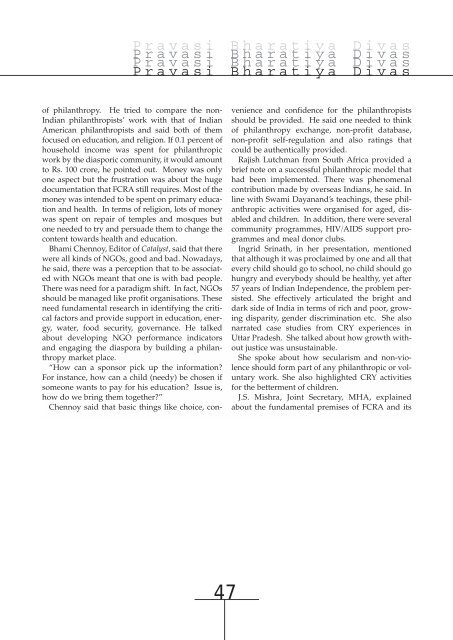
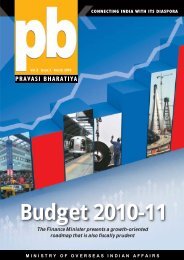
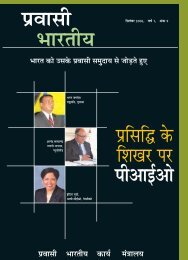


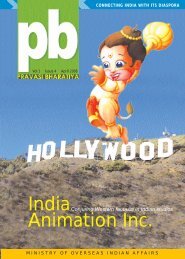
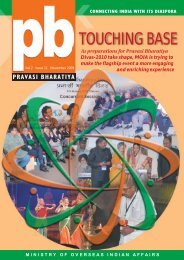
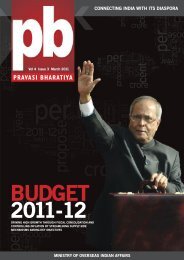

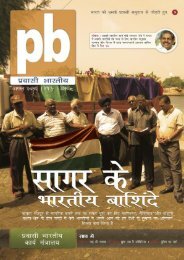
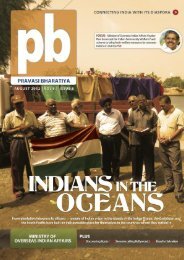
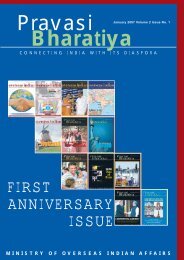


![flaxkiqj feuh izoklh Hkkjrh; fnol] vDVwcj 9&11 - Overseas Indian](https://img.yumpu.com/43977040/1/184x260/flaxkiqj-feuh-izoklh-hkkjrh-fnol-vdvwcj-911-overseas-indian.jpg?quality=85)
